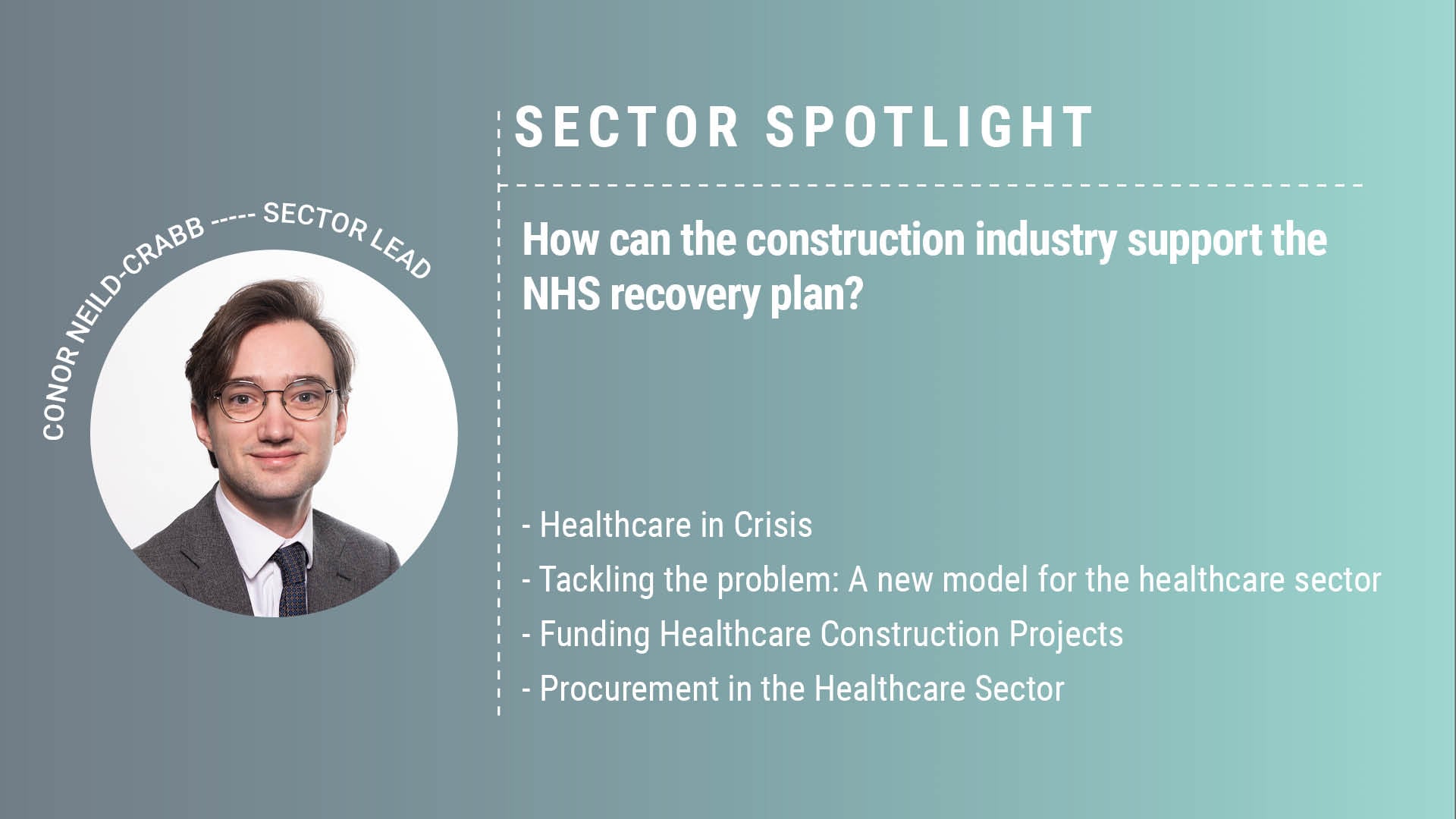Over the past two years the critical role of the National Health Service has been at the forefront of public demand, supporting the nation through Covid-19. As we emerge into the ‘new normal,’ the negative impact of the pandemic is exposing an unprecedented backlog in critical care services, a demand for essential maintenance works and delays to newbuild healthcare facilities. With the highest number of people waiting to receive planned NHS care since records began in 2007, the NHS recovery plan commits to reduce the backlog of care, drawing support from the Government’s recently legislated Health and Care Act 2022. Designed to enable better collaboration in healthcare, this Act forms part of the NHS Long Term Plan devised to ensure patients get the rapid care they need and to relieve pressure on A&Es.
In this article, Head of Strategy Conor Neild-Crabb discusses how the construction industry can support the NHS recovery plan.
Healthcare in Crisis
Prior to the pandemic in February 2020 there were already 4.43 million people on a waiting list for treatment and procedures. According to NHS England this has risen to an all-time record of over 6.1 million people waiting for care. The total number of patients waiting over 18 weeks for treatment now exceeds two million, while the number of patients waiting over 12 months for treatment stands at almost 300,000 – a staggering 186 times the number waiting pre-pandemic. Fears are rising for a growing ‘hidden backlog,’ with 4.51 million fewer elective procedures and 31.39 million fewer outpatient attendances, this poses a real problem for a surge in future demand for healthcare services.
Despite 2.7 million people being referred for cancer checks during the last year, a record high, cancer targets are still being missed. The 93% target for patients to be seen within two weeks of an urgent GP referral for suspected cancer has not been met since May 2020. There are also pressures on hospital emergency departments as waiting times have soared. March 2022 saw a record-breaking 2.17 million people attend A&E pushing the percentage of people being seen within the four-hour target to an all-time low. GPs are also struggling to make referrals due to a shortage of capacity in secondary care, resulting in 87% of referrals between February 2020 and November 2021 being unsuccessful. A real concern for patients waiting for diagnostic treatment or mental health support.
Tackling the problem: A new model for the healthcare sector
Construction in the healthcare sector has been disrupted by the pandemic, but the current healthcare crisis has forced a rising demand for safe and sanitary facilities to tackle the treatment backlog and wait times. This has brought about a change in mindset towards the type of facilities that communities need. At the height of the pandemic hospitals were overrun with Covid patients, accelerating a need for innovation and modern methods of construction to expedite additional capacity. The NHS Nightingale hospitals were built in as little as nine days, transforming London’s ExCeL Centre into a thriving modern facility with 4,000 intensive care beds. In response, the Department for Health and Social Care, in collaboration with the NHS improvement team, are exploring ways of creating flexible and adaptable healthcare facilities. The provision will shift from conventional hospital buildings to a more community-led model, taking the form of community diagnostic centres and surgical hubs, considered to be ‘hospitals of the future.’
Funding Healthcare Construction Projects
The community-based model of care creates opportunities for smaller value projects as well as extensions and refurbishments of existing primary care facilities. Although the Government has terminated Private Finance Initiative Schemes (PFI) for infrastructure projects, existing contracts will continue and are expected to be ongoing until 2040. As demand for quality healthcare provision is at an all-time high, healthcare construction projects are set to boom over the next few years. It is expected that contract awards for public hospitals and surgeries, and health and medical centres will continue to dominate the total construction volume in the healthcare sector.
Following the October 2021 Spending and Budget Review, NHS England published their Capital guidance 2022-2025 outlining how NHS capital funding will be prioritised and allocated to improve hospitals, infrastructure, and frontline services. The 3-year investment plan will deliver new build hospitals, modernisation of the primary care estate, an improvement to mental health facilities, financial support to advance diagnostics and technology, and improvements to critical care services across the NHS. In a bid to ‘level up’ the UK, £4.2bn is allocated to building 40 new hospitals by 2030 as part of the biggest hospital building programme in a generation, and the upgrade of more than 70 hospitals; £2.3bn is to transform diagnostic services with at least 100 community diagnostic centres (CDCs) across England to permanently increase diagnostic capacity, and £2.1bn is for digital innovation to connect hospitals and other care organisations as an efficient ecosystem. There is a £1.5bn provision to support elective recovery, through the delivery of new surgical hubs and £450m for NHS mental health facilities.
So far, £600m has been invested through a Critical Infrastructure Fund (CIC) involving 178 NHS Trusts to help clear the critical maintenance backlog delivered through the Healthcare Infrastructure Plan (HIP), but there are no further plans for investment for 2022/23.
Procurement in the Healthcare Sector
In April, the Health and Care Act 2022 was granted Royal Assent, leading to a relaxation in procurement rules in delivering clinical care and removing a requirement for complex competitive tendering processes. The changes to clinical service procurement brought in by the Act will give the NHS and public health commissioners more flexibility over when to use competitive procurement processes. This reform aligns with the wider goals of the legislation that prioritises collaboration in how healthcare services are organised. An incentive for public sector healthcare projects to use established procurement frameworks where collaboration, trusted partners and achieving best value are key drivers.
From 1st July 2022, Integrated Care Systems (ICSs) are to be established, comprising 42 Integrated Care Boards (ICBs) and Integrated Care Partnerships (ICPs) as detailed in the NHS 2022/2023 priorities and operational planning guidance. Each ICS will have its own ICB, and they will function as statutory organisations to improve population health and set the localised strategic priorities within the NHS. ICBs once formed, will replace clinical commissioning groups (CCGs). ICSs will consider how they can encourage a diversity of providers, including voluntary and community sector (VCSE) organisations, who play a key role in supplying health and care services.
Building a sustainable and Net Zero Future for Healthcare Construction
All healthcare construction projects must align with the Delivering a ‘Net Zero’ National Health Service strategy which aims to reduce carbon emissions and improve local air quality with an overall goal to improve health and high-quality care for all, now and for future generations. The construction industry can help the healthcare sector ‘build back better’ and ‘build back sustainably.’ With a mandate for all public sector projects to enact the Government’s net zero by 2050 target, Procure Partnerships works with a sustainable supply chain to help our clients achieve and deliver on their environmental and social value commitments when procuring Healthcare projects.
Click Here To Download a Procure Partnerships Framework User Guide
Twitter
Linkedin

In Conor’s 7/8 years in the industry, he has emerged as an expert in procurement, demonstrating a profound understanding of structuring Procure Partnerships Frameworks, deciphering main contractor/consultant procurement intricacies, assessing competitor offerings, and steering special projects and new product development.



